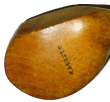
|
Registration Edit profile catalogue auction shopping cart shipping history makers search faq news links about contact |

Clubmakers
William Gibson
Kinghorn
 Born in Kirkcaldy in 1868, Gibson was another of the blacksmiths turned cleekmakers and, again, one who served his apprenticeship at the forge of James Anderson in Anstruther. He started in Edinburgh in 1887 as Stirling & Gibson but, in 1899, Stirling died. The firm's name changed to William Gibson & Co and, having bought a piece of land at Bowbutts at public auction in October 1902, moved to Kinghorn in 1903.
Born in Kirkcaldy in 1868, Gibson was another of the blacksmiths turned cleekmakers and, again, one who served his apprenticeship at the forge of James Anderson in Anstruther. He started in Edinburgh in 1887 as Stirling & Gibson but, in 1899, Stirling died. The firm's name changed to William Gibson & Co and, having bought a piece of land at Bowbutts at public auction in October 1902, moved to Kinghorn in 1903.By 1905 he had moved from just cleek making to club production. His best known were probably the Genii irons, the Hugh Logan model, with offset head and gooseneck hosel. This manufacture did not come without its problems. In 1908 Gison was sued in London by Benetfink & Co who owned the patent and gave Gibson sole manufacturing rights for the payment of a royalty. Gibson was to supply the clubs to Benetfink at 18s per dozen and could sell to the rest of the trade at 24s per dozen but not to any company selling the clubs retail at less than 6s 6d and especially not to Gamages, their competitor. Well, Gibson did, and did not supply to Benetfink, claiming Benetfink knew other companies had infringed the patent but not acted to protect it, meaning the club could not be sold for 6s 6d when identical versions were being sold for 5s. Too bad, said the judge, pay up!
In 1910, the business became a limited company with J P Cochrane being one of the three subscribers to the issue.
The company made many “signature” clubs, for James Braid, for example, and, more unusually for the 1920s, using the name of Joyce Wethered, perhaps the first woman to have a club range named for her.
Gibson eventually advertised as the world's largest producer of golf clubs and the new works, for which plans were submitted in January 1913, were the largest of their kind anywhere. Very shortly after Stirling’s death, Gibson dropped the Anderson Anstruther-style circle mark and adopted a five-pointed star as his cleek mark, a device which persisted throughout the life of the company although he also introduced other marks, a castle and a horn, for cheaper brands.
The First World War obviously affected the business in terms of supplies, demand, and manpower going to the army and as early as August 1914 the factory was on short-term working. Production never stopped completely and it bounced back quickly after the war and in 1921 organised and sponsored a championship over the Kinghorn links which attracted players such as Jock Hutchison, Joe Kirkwood, T G Renouf and Alex Herd.
Later that year, Gibson, a prominent local councillor, magistrate and justice of the peace, died suddenly.
Gibson was one of the firms which made use of dangawood shafts well into the metal-shafted era. As late as 1937, at the Carnoustie Open, they were promoting them as giving more distance than steel. Indeed, throughout their history, they paid huge attention to the wood for the shafts they made. Their top quality shafts were indicated by having the Gibson star stamped on them. At the time hickory supplies were running short in 1929, indeed only six months before the legalisation of steel shafts, T A Cochrane, the Gibson chairman, was telling the press that his was the only clubmaking firm which owned its own tracts of golf hickory in America from which they selected the best, milled there, then shipped to Glasgow.
The firm went into voluntary liquidation in 1955.
![]() Search the catalogue for
clubs by this maker
Search the catalogue for
clubs by this maker
site design dmc ltd | © 2000-2024 Antique Golf Clubs from Scotland